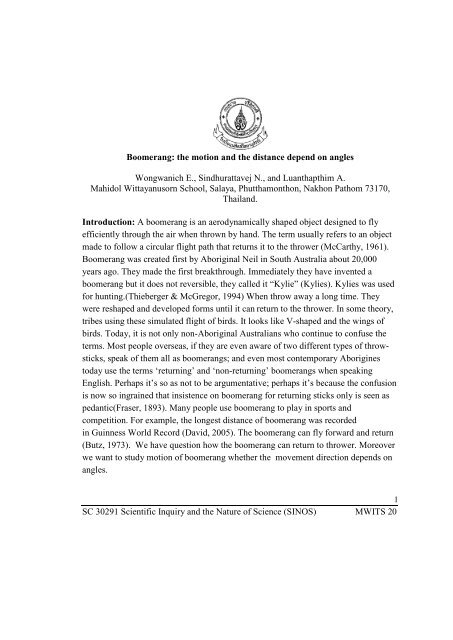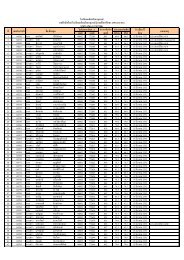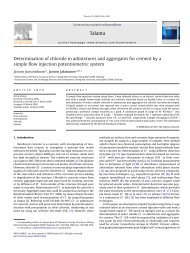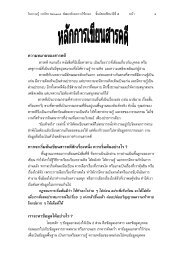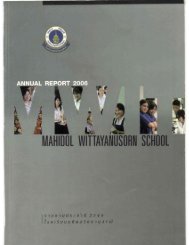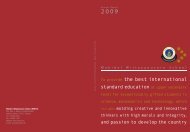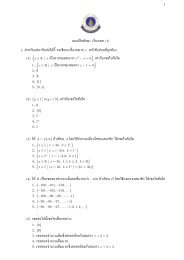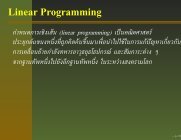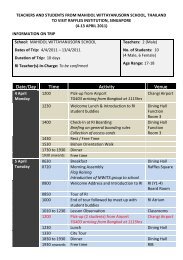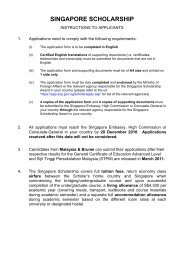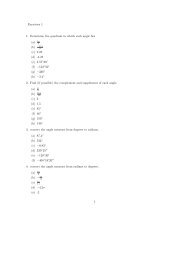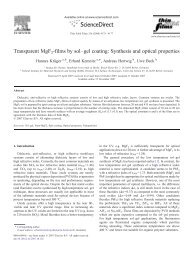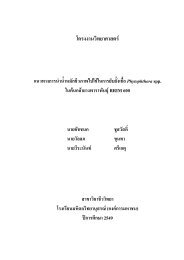SC 30291 Scientific Inquiry and the Nature of Science (SINOS ...
SC 30291 Scientific Inquiry and the Nature of Science (SINOS ...
SC 30291 Scientific Inquiry and the Nature of Science (SINOS ...
Create successful ePaper yourself
Turn your PDF publications into a flip-book with our unique Google optimized e-Paper software.
Boomerang: <strong>the</strong> motion <strong>and</strong> <strong>the</strong> distance depend on angles<br />
Wongwanich E., Sindhurattavej N., <strong>and</strong> Luanthapthim A.<br />
Mahidol Wittayanusorn School, Salaya, Phutthamonthon, Nakhon Pathom 73170,<br />
Thail<strong>and</strong>.<br />
Introduction: A boomerang is an aerodynamically shaped object designed to fly<br />
efficiently through <strong>the</strong> air when thrown by h<strong>and</strong>. The term usually refers to an object<br />
made to follow a circular flight path that returns it to <strong>the</strong> thrower (McCarthy, 1961).<br />
Boomerang was created first by Aboriginal Neil in South Australia about 20,000<br />
years ago. They made <strong>the</strong> first breakthrough. Immediately <strong>the</strong>y have invented a<br />
boomerang but it does not reversible, <strong>the</strong>y called it “Kylie” (Kylies). Kylies was used<br />
for hunting.(Thieberger & McGregor, 1994) When throw away a long time. They<br />
were reshaped <strong>and</strong> developed forms until it can return to <strong>the</strong> thrower. In some <strong>the</strong>ory,<br />
tribes using <strong>the</strong>se simulated flight <strong>of</strong> birds. It looks like V-shaped <strong>and</strong> <strong>the</strong> wings <strong>of</strong><br />
birds. Today, it is not only non-Aboriginal Australians who continue to confuse <strong>the</strong><br />
terms. Most people overseas, if <strong>the</strong>y are even aware <strong>of</strong> two different types <strong>of</strong> throwsticks,<br />
speak <strong>of</strong> <strong>the</strong>m all as boomerangs; <strong>and</strong> even most contemporary Aborigines<br />
today use <strong>the</strong> terms ‘returning’ <strong>and</strong> ‘non-returning’ boomerangs when speaking<br />
English. Perhaps it’s so as not to be argumentative; perhaps it’s because <strong>the</strong> confusion<br />
is now so ingrained that insistence on boomerang for returning sticks only is seen as<br />
pedantic(Fraser, 1893). Many people use boomerang to play in sports <strong>and</strong><br />
competition. For example, <strong>the</strong> longest distance <strong>of</strong> boomerang was recorded<br />
in Guinness World Record (David, 2005). The boomerang can fly forward <strong>and</strong> return<br />
(Butz, 1973). We have question how <strong>the</strong> boomerang can return to thrower. Moreover<br />
we want to study motion <strong>of</strong> boomerang whe<strong>the</strong>r <strong>the</strong> movement direction depends on<br />
angles.<br />
1<br />
<strong>SC</strong> <strong>30291</strong> <strong>Scientific</strong> <strong>Inquiry</strong> <strong>and</strong> <strong>the</strong> <strong>Nature</strong> <strong>of</strong> <strong>Science</strong> (<strong>SINOS</strong>) MWITS 20
Materials <strong>and</strong> Methods: First used <strong>the</strong> paper size 29.7 x 10.5 centimeters <strong>and</strong> folded<br />
follow <strong>the</strong> clip named “How to make an origami boomerang” or website<br />
http://www.youtube.com/watch?v=_kprLtErg8U. The boomerang has v-shape. Each<br />
wing <strong>of</strong> <strong>the</strong> boomerange is 15.0 centimeters <strong>and</strong> <strong>the</strong> width <strong>of</strong> each wing is 2.6<br />
centimeters. When we threw <strong>the</strong> boomerang, we would study <strong>the</strong> distance that<br />
depends on <strong>the</strong> angles by setup <strong>the</strong> angles at 30, 45, 60, 90 degrees <strong>and</strong> <strong>the</strong>n we<br />
collected data by repeating 10 times for each angle. Then we would measure along <strong>the</strong><br />
x-axis by measuring <strong>the</strong> distance from <strong>the</strong> point <strong>of</strong> thrower.<br />
Results: After we throw <strong>the</strong> boomerang we collected <strong>the</strong> data <strong>of</strong> <strong>the</strong> distance. <strong>and</strong><br />
measured along <strong>the</strong> x-axis in meters unit.<br />
Table 1 The distance from <strong>the</strong> boomerang’s thrower that measures along x-axis 10<br />
times for each angles.<br />
0° 30° 45° 60° 90°<br />
1 0.06 1.64 2.05 1.98 3.76<br />
2 0.1 1.09 1.87 2.05 3.51<br />
3 0.15 1.12 1.92 2.14 3.76<br />
4 0.11 0.77 1.96 2.32 3.97<br />
5 0.03 0.94 1.88 2.09 3.38<br />
6 0.16 1.22 1.62 2.33 3.48<br />
7 0.12 1.2 1.83 2.15 4.08<br />
8 0.05 1.22 1.7 1.96 3.47<br />
9 0.29 1.67 1.65 2.23 3.6<br />
10 0.12 1 1.65 2.15 3.66<br />
SUM 1.19 11.87 18.13 21.4 36.67<br />
Average 0.119 1.187 1.813 2.14 3.667<br />
2<br />
<strong>SC</strong> <strong>30291</strong> <strong>Scientific</strong> <strong>Inquiry</strong> <strong>and</strong> <strong>the</strong> <strong>Nature</strong> <strong>of</strong> <strong>Science</strong> (<strong>SINOS</strong>) MWITS 20
Table 2 Anova: Single Factor, it shows <strong>the</strong> data <strong>and</strong> statistical analysis <strong>of</strong> data.<br />
Groups Count Sum Average Variance<br />
0 degree 10 1.19 0.119 0.005388<br />
30 degree 10 11.87 1.187 0.080512<br />
45 degree 10 18.13 1.813 0.022268<br />
60 degree 10 21.4 2.14 0.016156<br />
90 degree 10 36.67 3.667 0.051668<br />
Source <strong>of</strong><br />
Variation SS df MS F P-value F crit<br />
Between<br />
Groups 68.01893 4 17.00473 483.1134 2.49E-36 2.578739<br />
Within Groups 1.58392 45 0.035198<br />
Total 69.60285 49<br />
From this data, <strong>the</strong>re are differences significant statically. Then we plotted graph<br />
between distance <strong>and</strong> angle.<br />
Figure 1 The graph show <strong>the</strong> relationship between <strong>the</strong> distances <strong>and</strong> angles.<br />
Conclusion <strong>and</strong> Discussion: From <strong>the</strong> result, if we set <strong>the</strong> size <strong>of</strong> angles to 0 degree,<br />
<strong>the</strong> distance is <strong>the</strong> nearest. If we increase <strong>the</strong> angles, boomerang will fall far<strong>the</strong>r.<br />
When <strong>the</strong> degree <strong>of</strong> angle was increased, <strong>the</strong> orbit <strong>of</strong> boomerang will wider<br />
depends on angle. First we choose Printing paper for floding <strong>the</strong> boomerang <strong>and</strong> <strong>the</strong>n<br />
3<br />
<strong>SC</strong> <strong>30291</strong> <strong>Scientific</strong> <strong>Inquiry</strong> <strong>and</strong> <strong>the</strong> <strong>Nature</strong> <strong>of</strong> <strong>Science</strong> (<strong>SINOS</strong>) MWITS 20
we did <strong>the</strong> experiment, we found that <strong>the</strong> boomerang were fallen <strong>the</strong> floor too fast.<br />
After that we Used card paper instead <strong>of</strong> <strong>the</strong> printing paper for folding <strong>the</strong> boomerang<br />
colour paper to fold boomerang, we found <strong>the</strong> colour-paper boomerang fly in air<br />
longer than A4 paper boomerang We found that <strong>the</strong> card paper boomerangs can hold<br />
on. Forces also effect to <strong>the</strong> distance because when we used more force to throw. The<br />
boomerang will spinned fastly <strong>and</strong> return to thrower quickly.<br />
According to <strong>the</strong> research, factors which effect to <strong>the</strong> distance are:<br />
1. Size <strong>of</strong> angle – If angle increases <strong>the</strong> orbit will wider too <strong>and</strong> boomerang will<br />
fall too slow.<br />
2. Force – If we use more force to throw, <strong>the</strong> boomerang will fall far<strong>the</strong>r.<br />
3. Materials to make boomerang – If materials that make <strong>the</strong> boomerang is hard.<br />
The boomerang<br />
References:<br />
Butz, T. (1973). The motion <strong>and</strong> principle <strong>of</strong> gyroscope. Boomerang throwing: notes<br />
for instructors, 20, 125-137.<br />
David, S. (Reporter). (2005, March 15). The longest throw with <strong>the</strong> boomerang,<br />
Canberra: Australia Murrarie Production.<br />
Fraser, J. (1893). Aborigines <strong>of</strong> New South Wales, Pamphlets issued by <strong>the</strong> NSW<br />
Commissioners for <strong>the</strong> World’s Columbian Exposition, 2, 415-450.<br />
McCarthy, F.D.(1961). The Boomerang. The Australian Museum Magazine,13,<br />
25-34.<br />
Thieberger, N., & McGregor, W. (1994), The origin <strong>of</strong> boomerang & Aborigins.<br />
Macquarie Aboriginal Words, 22, 322-389.<br />
Acknowledgements:<br />
We thank you Ms.Usa Jeenjenkit, Mr.Washirasorn Saengsuwan <strong>and</strong>Ms.Sirimard<br />
Sukpraserd for giving us <strong>the</strong> comments <strong>and</strong> suggestions about <strong>the</strong> experiment <strong>and</strong><br />
writing report.<br />
4<br />
<strong>SC</strong> <strong>30291</strong> <strong>Scientific</strong> <strong>Inquiry</strong> <strong>and</strong> <strong>the</strong> <strong>Nature</strong> <strong>of</strong> <strong>Science</strong> (<strong>SINOS</strong>) MWITS 20


